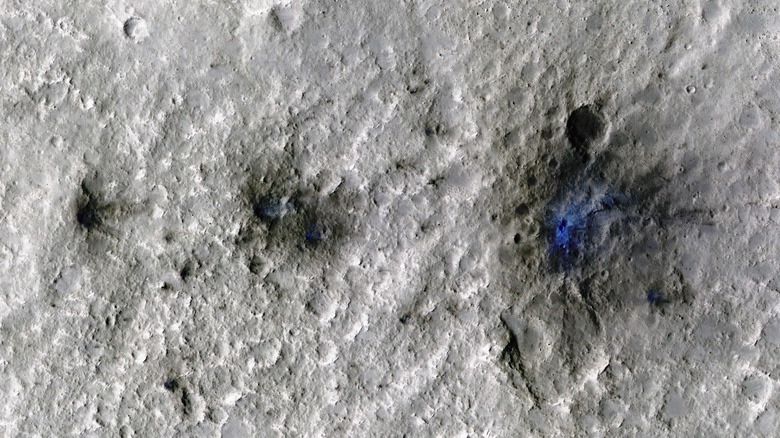How A NASA Lander Heard Its First Meteoroid Impact
Of all the ways that we explore Mars — from taking photos from orbit, to sending rovers to pick up and analyze rocks from the surface — one method you might not know about is the use of seismometers. Just like how Earth experiences earthquakes, Mars experiences "marsquakes," and NASA's InSight lander is armed with a seismometer to detect these shakes. Studying "marsquakes" helps scientists learn about the interior of the planet, and data from InSight has provided more detailed information about the size of different parts of Mars' interior than ever before.
But it turns out that's not all that InSight can do. Scientists recently shared that they were able to detect the vibrations from meteoroids that struck the Martian surface. In the Nature Geoscience journal, researchers shared that they had used InSight's instruments to detect four impact events between 2020 and 2021.
The first impact detected was the biggest; the rock that sailed through the Martian atmosphere and hit the surface exploded into pieces, and left at least three craters on the ground (per JPL). The craters were confirmed by the Mars Reconnaissance Orbiter, an orbiting spacecraft which takes high-resolution images of the Martian surface.
"After three years of InSight waiting to detect an impact, those craters looked beautiful," said one of the researchers, Ingrid Daubar of Brown University.
Why study craters
Mars is covered in many craters for the same reason that the moon is. There are tons of bits of space rock floating around, and over millions of years, many of these pieces of rock crash into moons or planets and leave behind impact craters. Earth has been crashed into by many meteoroids too, but not so many impact craters remain here. That's because Earth has plate tectonics, which means that the surface of our planet is constantly renewed, so impact craters don't stick around as long. Mars, like the moon, does not have plate tectonics.
Another important difference is in atmosphere. Earth's thick atmosphere means we have plenty of wind that's causing erosion, which gradually wears down craters over time. The moon has no atmosphere, and Mars has only a very thin atmosphere, so there is much less erosion.
All of this means that impact craters hang around a lot longer on Mars than on Earth, and studying them is a key way we can learn about the planet's history. In fact, according to JPL, scientists using InSight were surprised they didn't detect more impacts than just these four because Mars is close to the asteroid belt in our solar system. However, from the impacts they did detect, they were able to see things like how the ground tilts when an impact happens.
"We're learning more about the impact process itself," said lead author of the study Raphael Garcia of Institut Supérieur de l'Aéronautique et de l'Espace in France. "We can match different sizes of craters to specific seismic and acoustic waves now."

